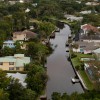 Throughout Florida’s history, humans have altered the coastlines, leading to large-scale degradation of coastal ecosystems. This has led to the loss of associated ecosystem services, including products such as food and timber and processes like coastal protection and disease control. Unfortunately, ecosystem restoration efforts have not always been a priority for coastal management. This 10-page literature review surveys the available ecosystem-service valuation literature for five of Florida’s coastal natural communities–oyster reefs, beach dunes, mangrove forests, seagrass beds, and salt marshes–to facilitate the quantification of ecosystem services to provide a better measure of the full impact of restoration efforts. Written by Susanna Blair, Carrie Adams, Tom Ankersen, Maia McGuire, and David Kaplan, and published by the UF Department of Sea Grant, November 2014. (UF/IFAS photo by Tyler Jones)
Throughout Florida’s history, humans have altered the coastlines, leading to large-scale degradation of coastal ecosystems. This has led to the loss of associated ecosystem services, including products such as food and timber and processes like coastal protection and disease control. Unfortunately, ecosystem restoration efforts have not always been a priority for coastal management. This 10-page literature review surveys the available ecosystem-service valuation literature for five of Florida’s coastal natural communities–oyster reefs, beach dunes, mangrove forests, seagrass beds, and salt marshes–to facilitate the quantification of ecosystem services to provide a better measure of the full impact of restoration efforts. Written by Susanna Blair, Carrie Adams, Tom Ankersen, Maia McGuire, and David Kaplan, and published by the UF Department of Sea Grant, November 2014. (UF/IFAS photo by Tyler Jones)
http://edis.ifas.ufl.edu/sg134
Tag: Tom Ankersen
A Multi-Disciplinary Review of Current Sea-Level Change Research in Florida (TP193/SG125)
 Sea-level rise is an issue of paramount importance for the state of Florida due to its lengthy coastline, low relief, high coastal population density, ecologically and economically vital beaches, estuaries, and wetlands, and porous limestone geology. The rate of sea-level rise in Florida generally follows the global average (~3 mm per year) and is slowly gaining public attention as a significant threat to the natural and socioeconomic future of the state. This 18-page multi-disciplinary review provides an annotated bibliographic summary of current peer-reviewed literature regarding sea-level rise in Florida. Written by Anna Cathey Linhoss, Lisa Gardner Chambers, Kevin Wozniak, and Tom Ankersen, and published by the UF Department of Sea Grant, February 2013.
Sea-level rise is an issue of paramount importance for the state of Florida due to its lengthy coastline, low relief, high coastal population density, ecologically and economically vital beaches, estuaries, and wetlands, and porous limestone geology. The rate of sea-level rise in Florida generally follows the global average (~3 mm per year) and is slowly gaining public attention as a significant threat to the natural and socioeconomic future of the state. This 18-page multi-disciplinary review provides an annotated bibliographic summary of current peer-reviewed literature regarding sea-level rise in Florida. Written by Anna Cathey Linhoss, Lisa Gardner Chambers, Kevin Wozniak, and Tom Ankersen, and published by the UF Department of Sea Grant, February 2013.
http://edis.ifas.ufl.edu/sg125